airbag SAAB 9-5 2003 Owners Manual
[x] Cancel search | Manufacturer: SAAB, Model Year: 2003, Model line: 9-5, Model: SAAB 9-5 2003Pages: 288, PDF Size: 16.78 MB
Page 5 of 288
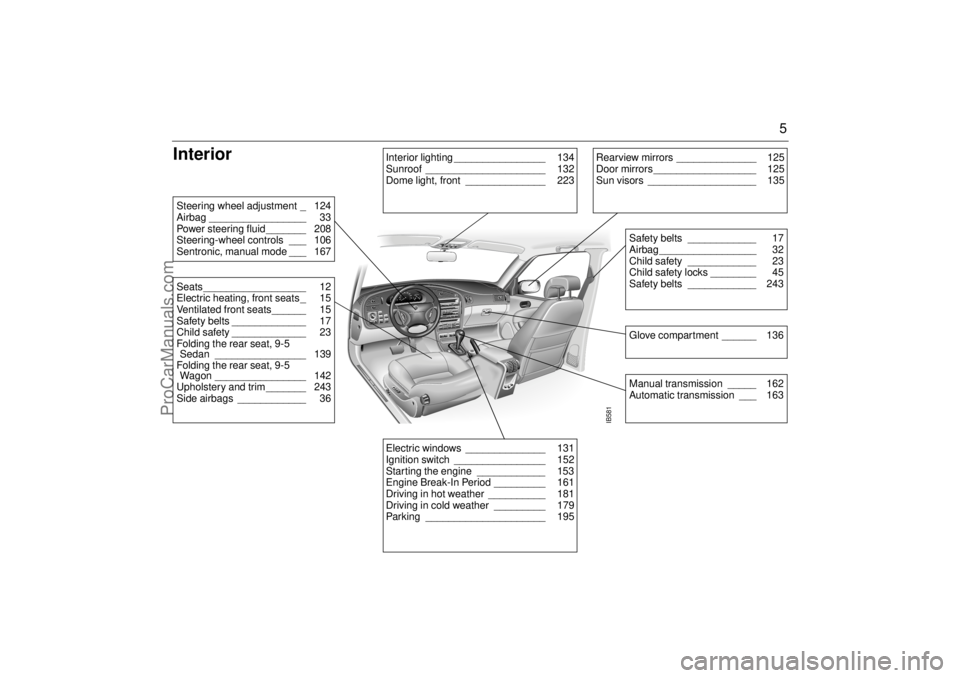
5
Interior
IB581
Rearview mirrors ______________ 125
Door mirrors __________________ 125
Sun visors ___________________ 135
Safety belts ____________ 17
Airbag _________________ 32
Child safety ____________ 23
Child safety locks ________ 45
Safety belts ____________ 243Glove compartment ______ 136Manual transmission _____ 162
Automatic transmission ___ 163
Electric windows ______________ 131
Ignition switch ________________ 152
Starting the engine ____________ 153
Engine Break-In Period _________ 161
Driving in hot weather __________ 181
Driving in cold weather _________ 179
Parking _____________________ 195
Steering wheel adjustment _ 124
Airbag _________________ 33
Power steering fluid _______ 208
Steering-wheel controls ___ 106
Sentronic, manual mode ___ 167Seats __________________ 12
Electric heating, front seats _ 15
Ventilated front seats______ 15
Safety belts _____________ 17
Child safety _____________ 23
Folding the rear seat, 9-5
Sedan ________________ 139
Folding the rear seat, 9-5
Wagon ________________ 142
Upholstery and trim _______ 243
Side airbags ____________ 36
Interior lighting ________________ 134
Sunroof _____________________ 132
Dome light, front ______________ 223
ProCarManuals.com
Page 10 of 288

10
No sparks,
flames or
smoking.Buckle up
Use protective
gogglesAirbag
Keep out of
reach of
children.Electric
windows
Battery acid
contains
sulphuric acid.Central
locking
Refer to the
Owner’s
Manual.Never place a
rear-facing
child seat in
this seat.
Risk of
explosive gas.
HeadlightsWindshield
wipers
Direction
indicatorsWindshield
washers
Parking lights Defroster
Hazard
warning lightsRear window
heating
Front fog
lightsVentilation fan
Rear fog lights
Coolant
temperatureRadiator fan
Battery
chargingFuel
Foot brake
Coolant level
Engine oil
pressure
ABS brakes
Examples of symbols that can be found in your car
ProCarManuals.com
Page 11 of 288
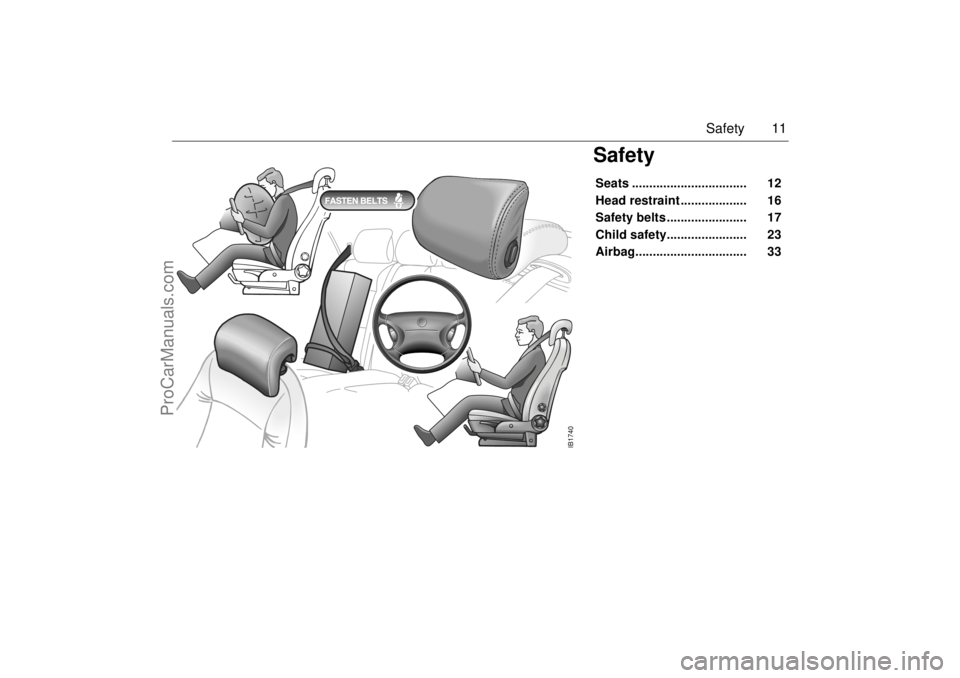
11 Safety
SafetySeats ................................. 12
Head restraint ................... 16
Safety belts ....................... 17
Child safety....................... 23
Airbag................................ 33
IB1740
ProCarManuals.com
Page 12 of 288

12 SafetySeats Both front seats are electrically operated.
On certain models the driver´s seat is
equipped with a memory function.
To facilitate getting into the car, both seats
can be adjusted when either of the front
doors is open.
For safety reasons, if the door is closed, the
seat can only be adjusted when the ignition
is ON.
Note, however, that both seats can be
adjusted for 30 seconds after both doors
have been closed. The following seat adjustments can be
made to achieve a comfortable driving
position:
height
legroom
backrest rake angle
lumbar support
head-restraint height
We recommend that adjustments to the
driver’s seat be performed in the following
order:
1height
2 legroom
3 seat tilt angle
4 backrest rake angle
Lastly, adjust the steering wheel (see page
124).
Side airbags (see page 36).Head restraint(see page 16).
Height To raise the seat, lift the lower control
straight up.
To lower the seat, press the lower control
down.
The same control can be used to adjust the
height of the front and rear edges of the seat
independently.
WARNING
The seats are actuated by powerful
motors. Bear this in mind when adjusting
the seat, and make sure that nothing gets
caught and damaged. Ensure that noth-
ing can be trapped when adjusting the
seat.
Bear in mind that children can be injured
if they play with the electrically-operated
seats.
Always remove the ignition key when you
leave the car to prevent personal injury
caused by the electrically adjustable
seats, for example, due to children play-
ing.
WARNING
Never adjust the driver’s seat except
when the car is stationary.
IB401
ProCarManuals.com
Page 13 of 288
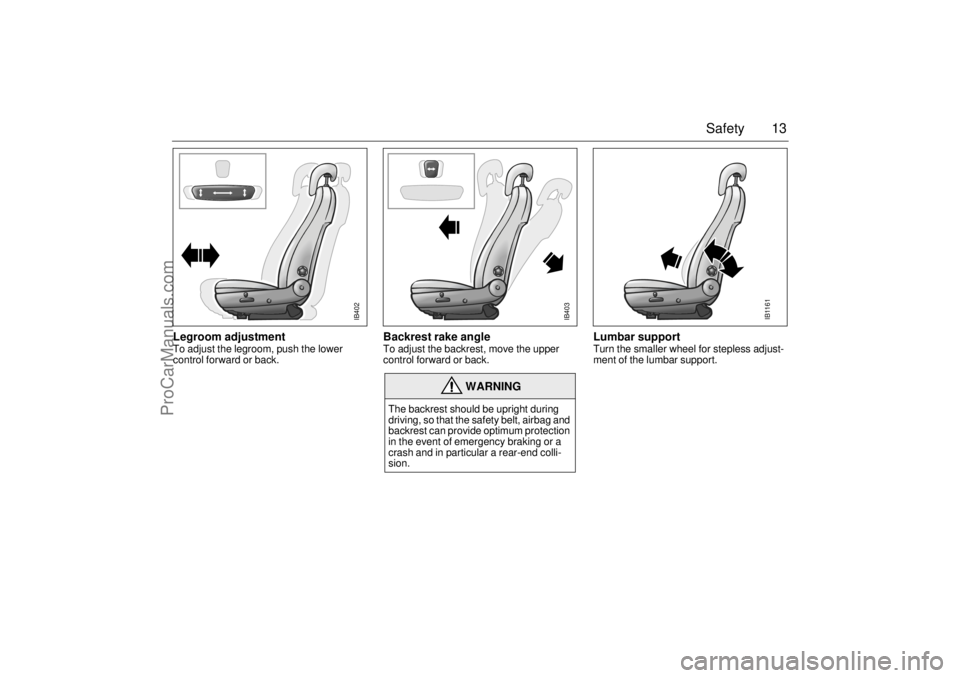
13 Safety
Legroom adjustment To adjust the legroom, push the lower
control forward or back.
Backrest rake angle To adjust the backrest, move the upper
control forward or back.
Lumbar supportTurn the smaller wheel for stepless adjust-
ment of the lumbar support.
WARNING
The backrest should be upright during
driving, so that the safety belt, airbag and
backrest can provide optimum protection
in the event of emergency braking or a
crash and in particular a rear-end colli-
sion.
IB402
IB403
IB1161
ProCarManuals.com
Page 23 of 288
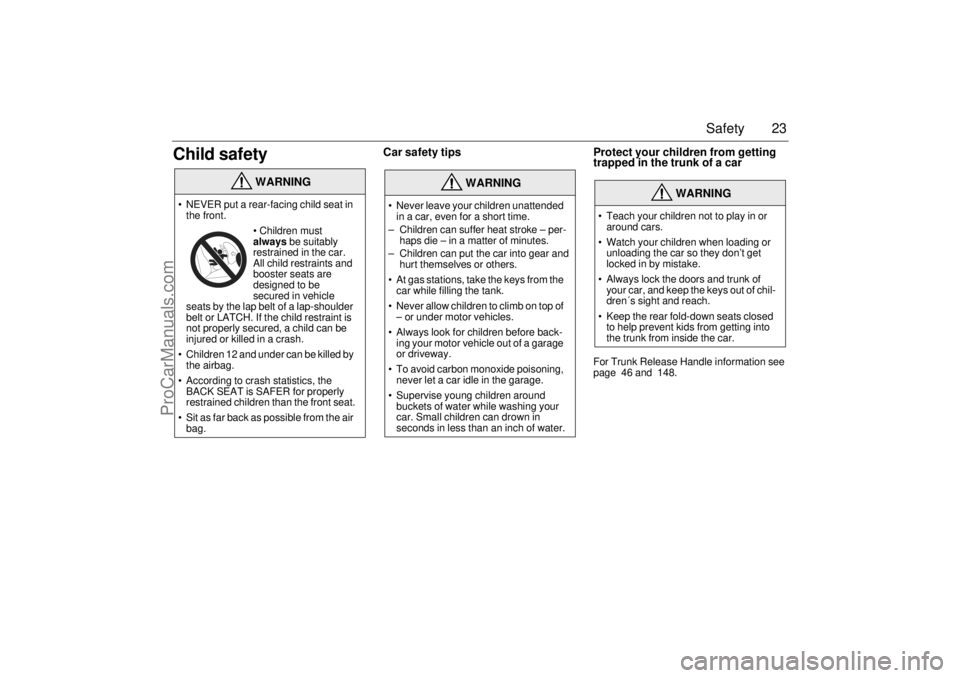
23 Safety
Child safety
Car safety tips Protect your children from getting
trapped in the trunk of a car
For Trunk Release Handle information see
page 46 and 148.
WARNING
NEVER put a rear-facing child seat in
the front.
Children must
always be suitably
restrained in the car.
All child restraints and
booster seats are
designed to be
secured in vehicle
seats by the lap belt of a lap-shoulder
belt or LATCH. If the child restraint is
not properly secured, a child can be
injured or killed in a crash.
Children 12 and under can be killed by
the airbag.
According to crash statistics, the
BACK SEAT is SAFER for properly
restrained children than the front seat.
Sit as far back as possible from the air
bag.
WARNING
Never leave your children unattended
in a car, even for a short time.
– Children can suffer heat stroke – per-
haps die – in a matter of minutes.
– Children can put the car into gear and
hurt themselves or others.
At gas stations, take the keys from the
car while filling the tank.
Never allow children to climb on top of
– or under motor vehicles.
Always look for children before back-
ing your motor vehicle out of a garage
or driveway.
To avoid carbon monoxide poisoning,
never let a car idle in the garage.
Supervise young children around
buckets of water while washing your
car. Small children can drown in
seconds in less than an inch of water.
WARNING
Teach your children not to play in or
around cars.
Watch your children when loading or
unloading the car so they don’t get
locked in by mistake.
Always lock the doors and trunk of
your car, and keep the keys out of chil-
dren´s sight and reach.
Keep the rear fold-down seats closed
to help prevent kids from getting into
the trunk from inside the car.
ProCarManuals.com
Page 33 of 288
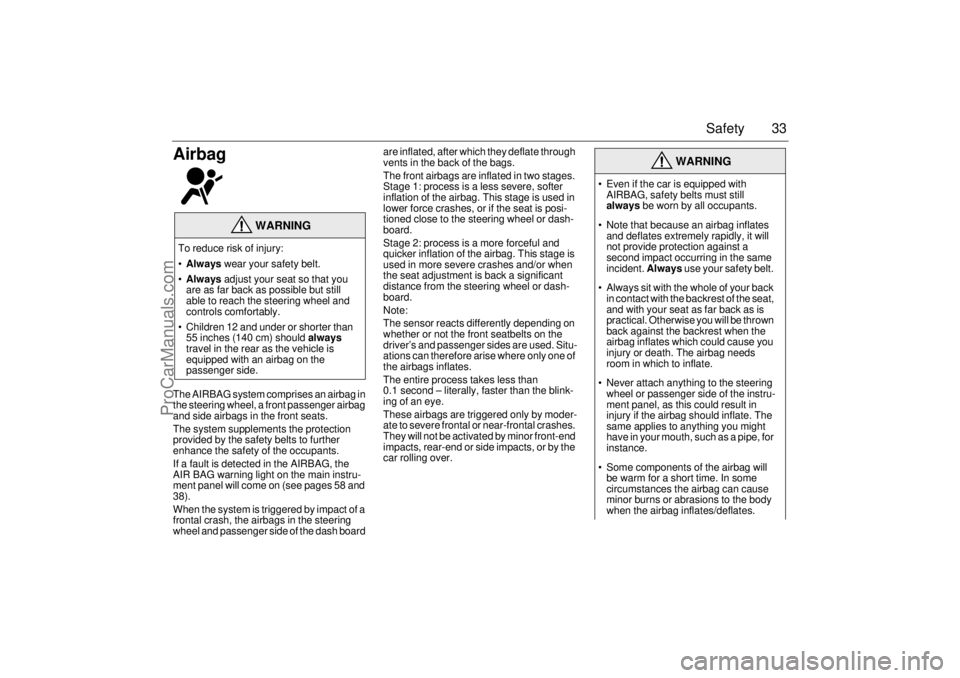
33 Safety
Airbag The AIRBAG system comprises an airbag in
the steering wheel, a front passenger airbag
and side airbags in the front seats.
The system supplements the protection
provided by the safety belts to further
enhance the safety of the occupants.
If a fault is detected in the AIRBAG, the
AIR BAG warning light on the main instru-
ment panel will come on (see pages 58 and
38).
When the system is triggered by impact of a
frontal crash, the airbags in the steering
wheel and passenger side of the dash board are inflated, after which they deflate through
vents in the back of the bags.
The front airbags are inflated in two stages.
Stage 1: process is a less severe, softer
inflation of the airbag. This stage is used in
lower force crashes, or if the seat is posi-
tioned close to the steering wheel or dash-
board.
Stage 2: process is a more forceful and
quicker inflation of the airbag. This stage is
used in more severe crashes and/or when
the seat adjustment is back a significant
distance from the steering wheel or dash-
board.
Note:
The sensor reacts differently depending on
whether or not the front seatbelts on the
driver’s and passenger sides are used. Situ-
ations can therefore arise where only one of
the airbags inflates.
The entire process takes less than
0.1 second – literally, faster than the blink-
ing of an eye.
These airbags are triggered only by moder-
ate to severe frontal or near-frontal crashes.
They will not be activated by minor front-end
impacts, rear-end or side impacts, or by the
car rolling over.
WARNING
To reduce risk of injury:
Always wear your safety belt.
Always adjust your seat so that you
are as far back as possible but still
able to reach the steering wheel and
controls comfortably.
Children 12 and under or shorter than
55 inches (140 cm) should always
travel in the rear as the vehicle is
equipped with an airbag on the
passenger side.
WARNING
Even if the car is equipped with
AIRBAG, safety belts must still
always be worn by all occupants.
Note that because an airbag inflates
and deflates extremely rapidly, it will
not provide protection against a
second impact occurring in the same
incident. Always use your safety belt.
Always sit with the whole of your back
in contact with the backrest of the seat,
and with your seat as far back as is
practical. Otherwise you will be thrown
back against the backrest when the
airbag inflates which could cause you
injury or death. The airbag needs
room in which to inflate.
Never attach anything to the steering
wheel or passenger side of the instru-
ment panel, as this could result in
injury if the airbag should inflate. The
same applies to anything you might
have in your mouth, such as a pipe, for
instance.
Some components of the airbag will
be warm for a short time. In some
circumstances the airbag can cause
minor burns or abrasions to the body
when the airbag inflates/deflates.
ProCarManuals.com
Page 34 of 288
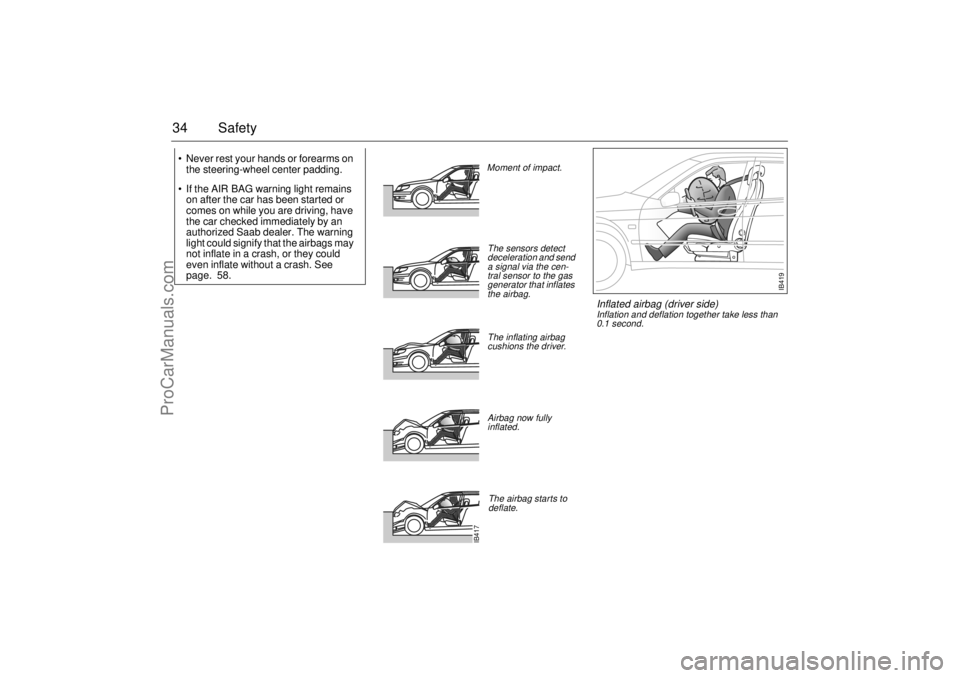
34 Safety Never rest your hands or forearms on
the steering-wheel center padding.
If the AIR BAG warning light remains
on after the car has been started or
comes on while you are driving, have
the car checked immediately by an
authorized Saab dealer. The warning
light could signify that the airbags may
not inflate in a crash, or they could
even inflate without a crash. See
page. 58.
IB417Moment of impact.
The sensors detect
deceleration and send
a signal via the cen-
tral sensor to the gas
generator that inflates
the airbag.
The inflating airbag
cushions the driver.
Airbag now fully
inflated.
The airbag starts to
deflate.
IB419
Inflated airbag (driver side) Inflation and deflation together take less than
0.1 second.
ProCarManuals.com
Page 35 of 288
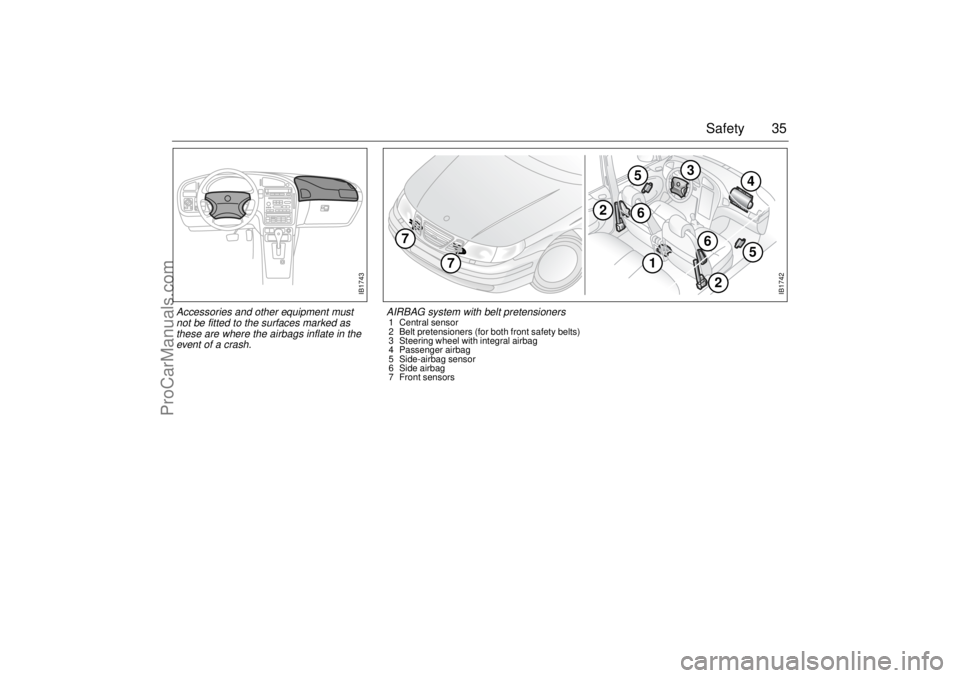
35 Safety
IB1742
5
1
4
2
6
3
2
6
7
7
5
AIRBAG system with belt pretensioners 1 Central sensor
2 Belt pretensioners (for both front safety belts)
3 Steering wheel with integral airbag
4 Passenger airbag
5 Side-airbag sensor
6 Side airbag
7 Front sensors
IB1743
Accessories and other equipment must
not be fitted to the surfaces marked as
these are where the airbags inflate in the
event of a crash.
ProCarManuals.com
Page 36 of 288
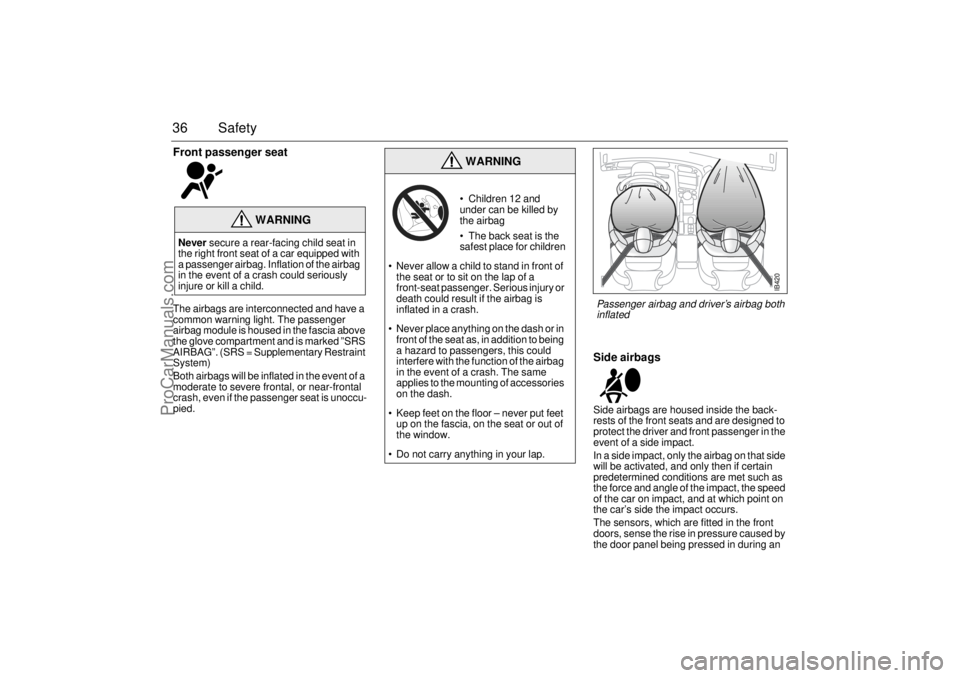
36 SafetyFront passenger seat The airbags are interconnected and have a
common warning light. The passenger
airbag module is housed in the fascia above
the glove compartment and is marked ”SRS
AIRBAG”. (SRS = Supplementary Restraint
System)
Both airbags will be inflated in the event of a
moderate to severe frontal, or near-frontal
crash, even if the passenger seat is unoccu-
pied.
Side airbags Side airbags are housed inside the back-
rests of the front seats and are designed to
protect the driver and front passenger in the
event of a side impact.
In a side impact, only the airbag on that side
will be activated, and only then if certain
predetermined conditions are met such as
the force and angle of the impact, the speed
of the car on impact, and at which point on
the car’s side the impact occurs.
The sensors, which are fitted in the front
doors, sense the rise in pressure caused by
the door panel being pressed in during an
WARNING
Never secure a rear-facing child seat in
the right front seat of a car equipped with
a passenger airbag. Inflation of the airbag
in the event of a crash could seriously
injure or kill a child.
WARNING Children 12 and
under can be killed by
the airbag
The back seat is the
safest place for children
Never allow a child to stand in front of
the seat or to sit on the lap of a
front-seat passenger. Serious injury or
death could result if the airbag is
inflated in a crash.
Never place anything on the dash or in
front of the seat as, in addition to being
a hazard to passengers, this could
interfere with the function of the airbag
in the event of a crash. The same
applies to the mounting of accessories
on the dash.
Keep feet on the floor – never put feet
up on the fascia, on the seat or out of
the window.
Do not carry anything in your lap.
IB420
Passenger airbag and driver’s airbag both
inflated
ProCarManuals.com